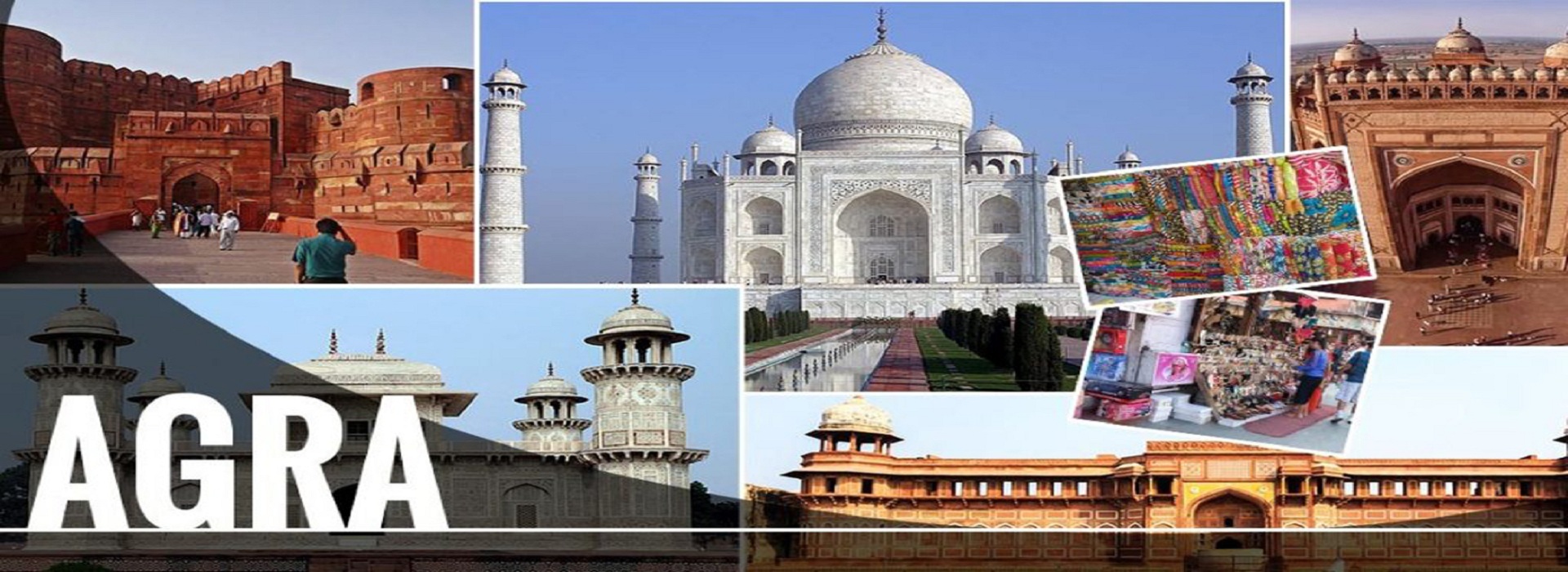Agra is popularly known as the Taj Mahal city. There are scores of top places to visit in Agra Tour. These places and monuments are mainly built during the Mughal epoch. The city has 3 world Heritage Sites – Taj Mahal, Agra Fort and Fatehpur Sikri. Besides these fabled places you have lots of choices to make your visit of Agra memorable. Discover how you can plan the tour and what places you should not miss during your Agra Sightseeing.
Taj Mahal

The Taj Mahal is one of the most famous examples of Mughal architecture. It is one of the top places to visit in Agra Tour. The structure was built in memory of Shah Jahan’s deceased wife, and is said to be the most perfect example of Mughal architecture. Its history and architecture are rich and diverse, with influences from Islamic, Indian, Ottoman Turkish and Persian styles of architecture. The Taj Mahal has captivated the imaginations of millions of people across the world, and its beauty is unrivaled in the world.
The Taj complex was designed with bilateral symmetry in mind. The two halves of the Taj are symmetrical and have a mirror image of each other. The architectural style also has Islamic significance because it is based on the Quran, which forbade the construction of anthropomorphic figures. To further honor the Quran, there are several passages of Arabic calligraphy on the exterior. Its symmetry is an important aspect of its history.
The four quartered Mughal gardens inspired by the Bagh e Jannat are surrounding the marble monument. These gardens are intersected by four channels of water with rows of gravity fed “Favvaras”(fountains). When these fountains rise in front of the Taj Mahal it’s a beautiful sight eagerly awaited and clicked by the tourist.
Agra Fort- One of the top Places to Visit in Agra

Agra Fort has a symmetrical, semicircular shape, and is located near the bank of the river Yamuna. The two-kilometer-long red sandstone walls surround the fort. The walls are adorned with lofty bastions and beautiful curves. Akbar commissioned the construction of the fort in 1565 and it took eight years to complete. Its walls were around 1.5 miles long and stood seventy feet high. The fort has a moat that protected the city from invading forces.
There are four gates in Agra Fort: the Delhi gate and the Lahore gate. The Delhi gate is the most recognizable, and the Lahore gate, built in 1702, is the most important .Amar Singh Gate these days is used to seek entry into the agra fort.
One of the salient features of Agra Fort is its array of palaces. The Shahjahani Mahal was constructed by Shah Jahan. It was originally red sandstone, but was later shell-plastered to appear white. Babur’s Baoli was another of the fort’s early changes.
The Jahangiri Mahal is the main zenana palace and was used by the Rajput wives of Akbar. This beautiful structure is filled with intricate stone carvings, heavy fashioned crossbeams and piers. The building has an interesting legend. The rooms inside the fort were filled with water, keeping the inhabitants cool even during the hottest summers. The fort has been home to many important royals over the centuries.
Tomb of Itimad-ud-Daulah
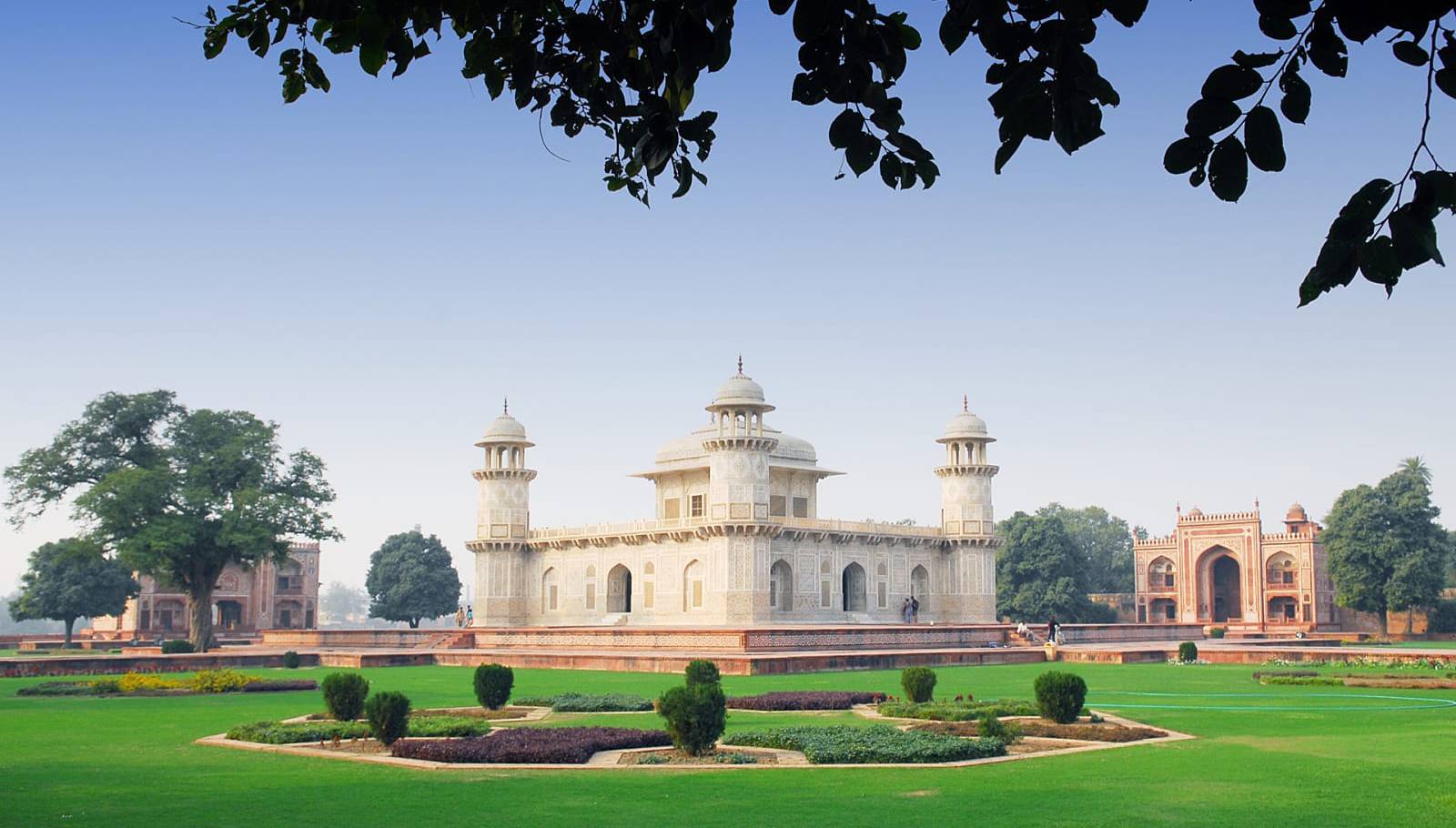
The tomb of Itimad-ud-Daulah is the only tomb in India that is built in marble. Unlike most of the Mughal monuments, this tomb lacks a dome. Its white marble facade and arched entrances mark a departure from the usual red sandstone style. The tomb is decorated with animate motifs, including fish, deer, birds, and a pavilion at the river’s edge.
The tomb of Itmad-ud-Daulah is fascinating and is one of the top places to visit in Agra after Taj Mahal. Its story begins with the story of Mirja Ghiyas Beg, a noble from Persia who went to the Mughal court and became a lord treasurer under Akbar. During his time with the Mughals, Jehangir fell in love with the daughter of Mirja Ghiyas Begh, Mehr-un-Nissa after her marriage with Jehangir was named Nurjahan.
The tomb was constructed in a garden setting and is meant to be an earthly representation of Paradise. Although smaller than Akbar’s tomb, Itmad-ud-Daulah’s tomb is an important visual marker of Mughal architecture. Its simplicity and Indo-Islamic features link it to Akbar’s tomb, while its use of materials and style create a unified composition.
The tomb of Itimad-ud-Daulah was built between 1622 and 1628. It was the first Mughal tomb to be built in white marble. It used stone inlay and pietra dura to decorate its exterior. The tomb is also known as the Little Taj or Baby Taj. Moreover, it inspired the Taj Mahal.
Tomb Of Sikandra

Sikandra tomb is a UNESCO World Heritage Site and is one of the top places to visit in Agra. This tomb is situated on the western periphery of the city, about ten kilometers outside of Agra. It’s most famous for being the final resting place of the Mughal emperor Akbar. Akbar was the greatest emperor of his time and inherited a tradition of oriental refinement and arts. Although the tomb was started after his death, it was not completed until Jahangir’s reign.
Akbar was influenced by the Char Minar in Deccan. This inspired him to construct his own tomb with four marble minarets on the gate. The four-storey minarets on the southern gate are reminiscent of a Char Minar, and are made up of three marble storeys. There are four gateways within the tomb, though only the southern one is used as an entrance. Moreover, the gates were made of red sandstone and marble, with designs inlay in black and,white.
The main entrance to Akbar’s tomb is the south gate. Floral and geometric arabesque embellishments decorate the wall of this monument. White marble minarets adorn the corners of the monument. The four causeways lead to the main tomb, which has a series of cubicles and arcaded verandas. The first two tiers are barred to the public and the last two are topped by four pointed towers. The third storey is divided into five segments, with a square room on each segment. The upper storey is a small open courtyard with an ornate sarcophagus and piers.
The interior of the tomb is equally stunning, and the details of the stucco paintings, geometric patterns, and floral patterns will leave you spellbound. The tomb is open to the public all year round ..
Rambagh Garden
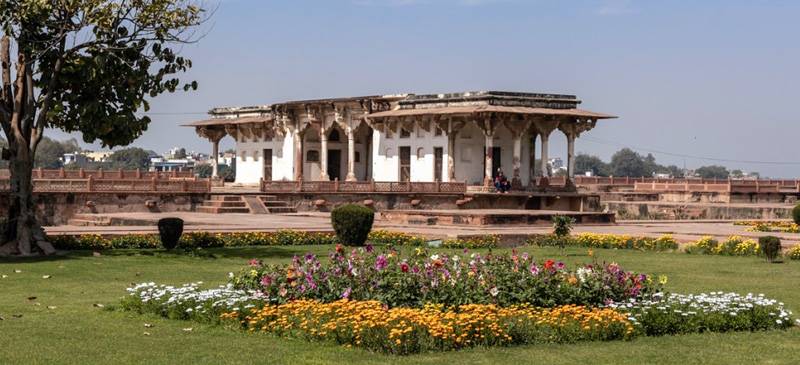
Rambagh is the oldest Mughal garden in Agra. It was built by Babur in 1526, and was later re-established by Nur Jahan after Jahangir’s death. It was used as a temporary resting place for Babur’s ashes. Originally known as Aram Bagh, it is built in the charbagh style. Rambagh is the oldest Mughal garden in the country and was built by Babur. It is beautifully crafted and was designed to mimic the Islamic concept of heaven, with canals and pathways. Located 5 km from the Taj Mahal, Rambagh is a popular spot for photographers.
The emperor of Mughal Empire commissioned Rambagh garden for himself as he was troubled by the severe summer of Agra . This beautiful location on the bank of river Yamuna amidst the sprawling greenery was a perfect place to spend a relaxing day.
Fatehpur Sikri – Top Places to Visit in Agra
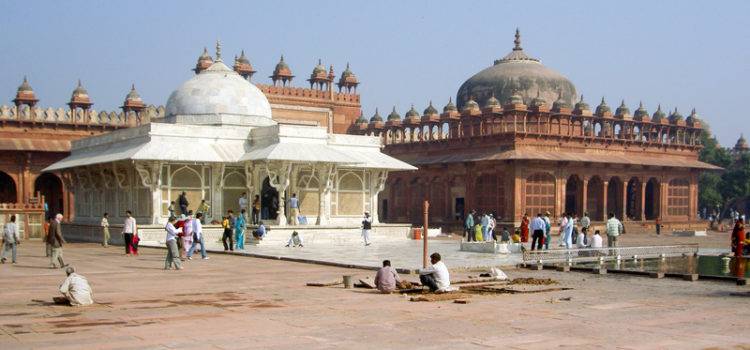
The town’s UNESCO-designated World Heritage Site status, makes it a must-see when visiting Agra. The city was the capital of the Mughal empire for 13 years under the reign of Emperor Akbar. The palaces were built to honor a Sufi saint and his son. Fatehpursikri is a UNESCO-listed World Heritage Site. A trip to Fatehpursikri is an incredible experience for history buffs.
The old city of Sikri was thriving in the mid-16th century. The Mughal emperor Akbar chose this location as his capital after the sufi saint Sheikh Salim Chishti in the village foretold the birth of his first son. Jehangir was born in the same village. The Sufi saint later helped Akbar build a religious compound for himself and the royal family. This walled city was later built in the region during Akbar’s Gujarat campaign and became known as Fatehpursikri, which means “City of Victory.”
Located 35 kilometers from Agra, Fatehpur Sikri is a city that offers a unique look at the Mughal era. The site’s auspicious reputation had existed long before Akbar’s reign. The Mughal emperor Babar visited Shaikh Salim Chishti in 1568 to pray for the birth of an heir. This is why the city has been named Sikri. This 16th-century Mughal city has a mixture of Mughal and Hindu styles. Its carved central pillar and red sandstone buildings are impressive. The city’s main attractions include the Jama Masjid mosque, the Tomb of Salim Chishti, the Diwan-E-Khas hall, and the Panch Mahal, a small palace overlooking the town
Mariam Tomb
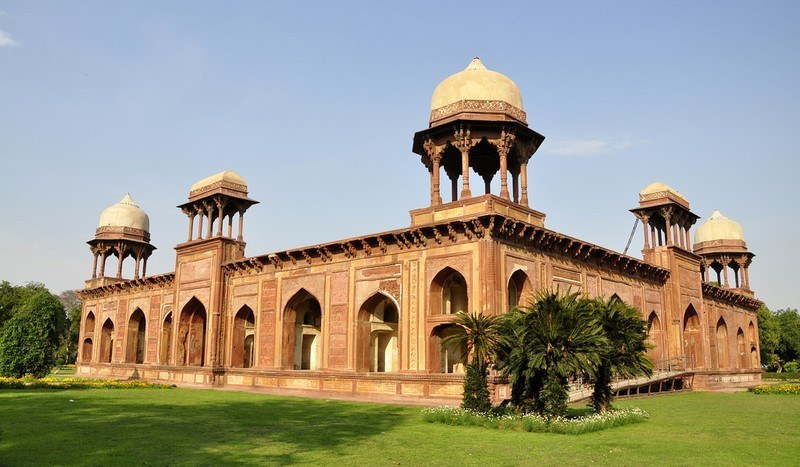
The Mariam Tomb in Agra is a prime example of the Mughal architectural style. Its intricate designs and floral carvings are accentuated by geometric patterns and common Islamic motifs. The tomb also has columns with hexagonal bases and carved friezes below the chajja. The monument opening hours are from sunrise to sunset daily. The monument has a separate entrance for visitors who are not citizens of India.
Inside, the main tomb is a massive structure, with octagonal towers on each corner and a lotus tank with a fountain in the middle. The tomb has three arches on the facade, including a central one that acts as an entrance. The side arches are closed by jalis and have a chhajja. The tomb also has a pavilion at the top, topped by slender pillars. The upper floor contains the marble cenotaph.
The structure, once a pleasure pavilion, was renovated and expanded by the Mughal emperor Jehangir. The tomb contains three tombstones, one on each side. The mausoleum has a terrace and cenotaph on the ground floor. The actual grave of Mariam lies beneath an underground mortuary chamber. In the center of the complex, the Mariam Tomb is one of the most famous attractions in Agra.
The Mariam Tomb in Agra is a prime example of Mughal style architecture. It is situated 13 km from Agra and is west of the Akbar’s Tomb. Mariam was the wife of the great Emperor Akbar and mother of Jahangir,
Mehtab Bagh

Mehtab Bagh is a square charbagh complex in Agra, India, situated north of the Taj Mahal complex, on the other side of the Yamuna River. The square gardens have three hundred and thirty metres in area and are aligned with Taj Mahal on the opposite bank. The garden is a popular tourist attraction and is definitely worth visiting during your trip to Agra. For more information about Mehtab Bagh, read this article!
The Mehtab Bagh garden is 25 acres of land with a central octagonal tank, a small baradari, and several smaller tanks. The gardens are beautifully landscaped and planted in traditional Mughal fashion, beginning with tall trees and ending with shrubs. Today, the garden is a popular tourist attraction. A visit to Mehtab Bagh will definitely make you feel nostalgic!
If you are looking for a place to view the Taj Mahal from a distance, the Mehtab Bagh park is the ideal place to do it! Although the Taj Mahal is closed on Fridays and Saturdays, Mehtab Bagh is an excellent place to catch a sunrise or sunset. Visitors are allowed to use cameras and mobile phones, but alcohol, food, and commercial photography are prohibited.
Dayalbagh Agra
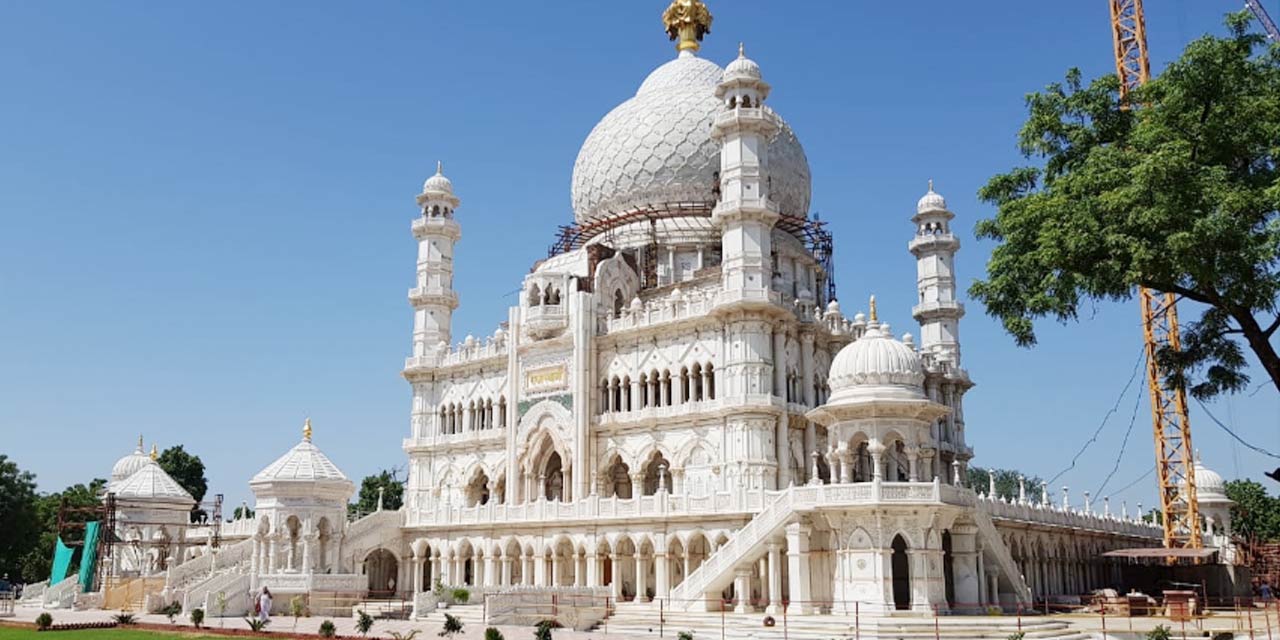
The Dayalbagh Samadh is similar to the Taj Mahal. It is constructed from white marble stone. It features eye-catching carving work and inlay. The construction of the Soami Bagh is nearly finished.It has been carried on unabated for the last 100 years, The monument is a sacred icon for the Radhaswami Faith. A visit here is worth the time. Once you are done admiring the marble work,
If you are visiting Agra, make sure to visit the Soami Bagh Samadh, also known as Dayal Bagh. This is a prime religious site, and is around 15 km from Agra. The temple, which is 110 feet tall, is the highlight of the area. Its enchanting landscape makes it an excellent destination for both religious and secular travelers.
The monument is home to the Radhasoami temple, which features a dome-topped place of worship.This was the place where first preacher of the Radha soami faith Huzur Soami ji Maharaj was cremated. The construction started around 100 years back and since then has been going on without a stop.
Chini Ka Rauza

The tomb of Allama Afzal Khan, a famous poet and scholar who served as prime minister to Mughal Emperor Shah Jahan, is located in Chini ka Rauza. The tomb is located one kilometer north of Itmad-Ud-Daulah Tomb and is surrounded by beautiful glazed tile work. Its beautiful architecture makes it a must-see.
Though now in a dilapidated state and finding not many visitors the tomb sure is a master piece of Mughal architecture. The glazed tiles were called Chini mitti and the same were used to decorate the outer façade of this tomb. This artwork can be seen in many Persian and central asian famous structures.

